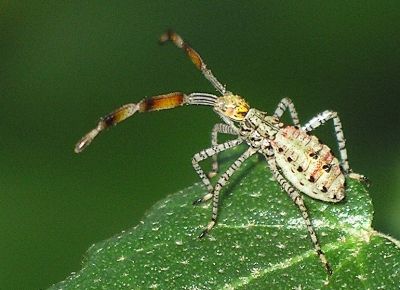by Valerie
January, 2005Coreid Bug Our featured animal this month has no common name. It is certainly a common insect in our yard, and I see this species all summer long. A member of the family Coreidae, in the suborder Heteroptera (true bugs), Hypselonotus punctiventris falls into a category that is usually called leaf-footed bugs, squash bugs, or coreid bugs. The first two descriptors do not fit this species because the adults do not have leaf-like legs nor do they feed on squash plants. To call it a coreid bug does little to distinguish it from the 2,000 or so other species in the same family, but will have to suffice. Besides discovering the species' name, I was unable to find any information at all about this creature. The only good source for identifying it was a catalogue of Central American insects, so Austin is probably in the northernmost area of its range. The individual pictured is a nymph. True bugs develop through gradual metamorphosis, which does not include a pupa, like butterflies or beetles. The eggs hatch into tiny nymphs. As these grow, they shed their skin five times. Each of the five growth stages of the nymph is called an instar. The fifth molt produces the adult, or imago. Sometimes the nymphs of bugs look so different from the adults that it is hard to identify them. I've seen enough of these distinctive coreid bugs, though, to recognize them through their entire development. I'm almost certain that the photograph above is a third instar. I've taken photos of two stages larger and more developed than this one and also the smaller second instar. A very curious thing about these nymphs is that the second and third instars have extra thick, long antennae. I've sometimes mistaken them for the legs of jumping spiders at first glance, especially when the bugs are hiding by flattening out against a leaf. This could be a useful mimicry device, or just coincidence, but the fourth instar has antennae no bigger than the previous stage (and so relatively much smaller), and the fifth instar has thin antennae like the adults. There is a small plant bug (in a different family but still in the same order) with bright markings that guards its even more brightly colored young as they feed on buds and seed pods in our garden. The nymphs of our featured coreid bug are quite similar in both color and size to the adults of that other insect. Most coreid bugs in our area, and there are quite a number of species, are dull colored, but this bug is a work of art. The ½ inch long adults retain the striped legs of the nymphs and also have tan, pink, and brown stripes on their bodies and wings. When they fly, their exposed backs reveal a flash of bright red. This is probably where the species name punctiventris comes in: puncti = stabbed, ventris = abdomen. Males are slightly more colorful than females. The insects feed on leaves and buds of various plants, sucking the juices. Because they don't occur in large numbers, they have never caused any damage to our gardens and so are just an interesting addition to our backyard fauna. Coreid bugs are known for producing strong scents, but I've never disturbed these enough to experience this first hand. It is quite probable that this species is exceptionally distasteful and advertises the fact to predators with its gaudy colors. The reason for its obscurity in field guides and other information sources remains a mystery. Such a pretty, interesting, and common insect should surely have drawn more attention from local naturalists. |